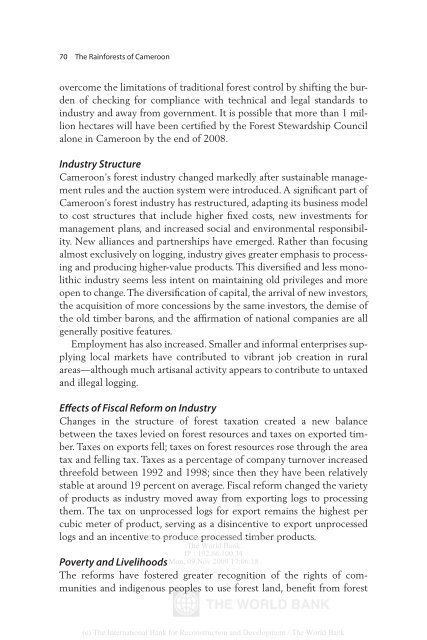The Rainforests of Cameroon - PROFOR
The Rainforests of Cameroon - PROFOR
The Rainforests of Cameroon - PROFOR
- No tags were found...
You also want an ePaper? Increase the reach of your titles
YUMPU automatically turns print PDFs into web optimized ePapers that Google loves.
70 <strong>The</strong> <strong>Rainforests</strong> <strong>of</strong> <strong>Cameroon</strong>overcome the limitations <strong>of</strong> traditional forest control by shifting the burden<strong>of</strong> checking for compliance with technical and legal standards toindustry and away from government. It is possible that more than 1 millionhectares will have been certified by the Forest Stewardship Councilalone in <strong>Cameroon</strong> by the end <strong>of</strong> 2008.Industry Structure<strong>Cameroon</strong>’s forest industry changed markedly after sustainable managementrules and the auction system were introduced. A significant part <strong>of</strong><strong>Cameroon</strong>’s forest industry has restructured, adapting its business modelto cost structures that include higher fixed costs, new investments formanagement plans, and increased social and environmental responsibility.New alliances and partnerships have emerged. Rather than focusingalmost exclusively on logging, industry gives greater emphasis to processingand producing higher-value products. This diversified and less monolithicindustry seems less intent on maintaining old privileges and moreopen to change. <strong>The</strong> diversification <strong>of</strong> capital, the arrival <strong>of</strong> new investors,the acquisition <strong>of</strong> more concessions by the same investors, the demise <strong>of</strong>the old timber barons, and the affirmation <strong>of</strong> national companies are allgenerally positive features.Employment has also increased. Smaller and informal enterprises supplyinglocal markets have contributed to vibrant job creation in ruralareas—although much artisanal activity appears to contribute to untaxedand illegal logging.Effects <strong>of</strong> Fiscal Reform on IndustryChanges in the structure <strong>of</strong> forest taxation created a new balancebetween the taxes levied on forest resources and taxes on exported timber.Taxes on exports fell; taxes on forest resources rose through the areatax and felling tax. Taxes as a percentage <strong>of</strong> company turnover increasedthreefold between 1992 and 1998; since then they have been relativelystable at around 19 percent on average. Fiscal reform changed the variety<strong>of</strong> products as industry moved away from exporting logs to processingthem. <strong>The</strong> tax on unprocessed logs for export remains the highest percubic meter <strong>of</strong> product, serving as a disincentive to export unprocessedlogs and an incentive Delivered to produce by <strong>The</strong> processed World Bank e-library timber to: products.<strong>The</strong> World BankIP : 192.86.100.34Poverty and LivelihoodsMon, 09 Nov 2009 17:06:18<strong>The</strong> reforms have fostered greater recognition <strong>of</strong> the rights <strong>of</strong> communitiesand indigenous peoples to use forest land, benefit from forest(c) <strong>The</strong> International Bank for Reconstruction and Development / <strong>The</strong> World Bank
















